
Bulletin 24, 1974
Home
Français
Introduction
History
Annual Index
Author &
Subject
Credits
Contact
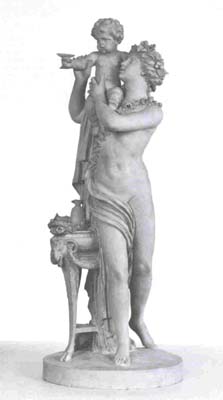
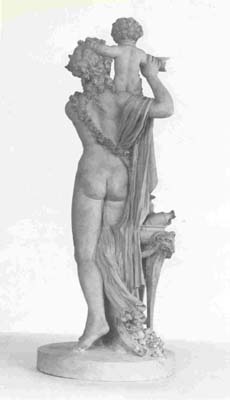
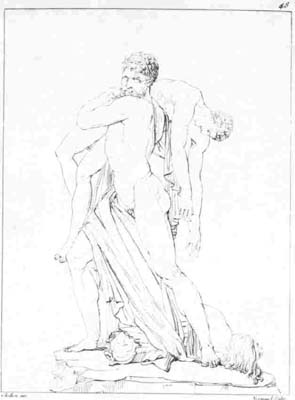
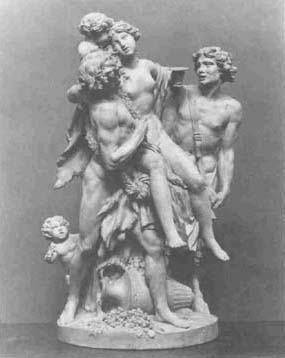
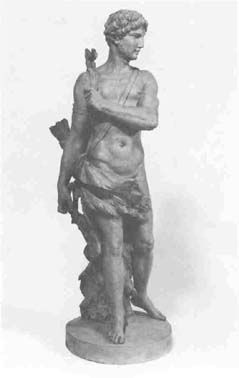
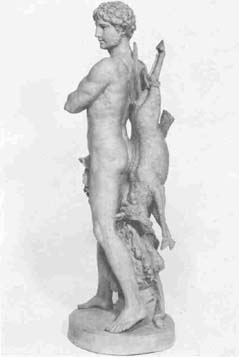

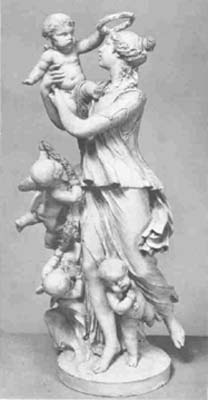

A
Clodian statuette in The National Gallery of Canada
by Terence Hodgkinson
Résumé en français
Pages 1 | 2
The nostalgia of the
Clodion world - "an enchanted eternally youthful family moving
among the scattered grapes, coming as if from some vendange, sated
with autumnal fullness" - has been well described by Michael
Levey; (1) and the mood of all the Clodion terracottas, it must be
admitted, is much the same. Perhaps partly for this reason they
receive little individual attention from scholars, and no attempt
to classify them has ever been published. Yet many are strongly
characterised and display formal inventiveness of a very high
order. They certainly deserve to be the subject of a catalogue
raisonné; and it may then be possible to speak with confidence
about Clodion's chronology and development. For the present, very
few generalisations can be supported by evidence.
There are formidable difficulties: the terracottas are not
specifically recorded in contemporary documents; they are now
widely dispersed in public and private collections; as they are
usually considered too fragile to travel, confrontations are rare;
one must beware of forgeries (for we know some were made as early as
the middle of the last century); finally, as is often remarked, the
large majority are undated. Yet little note has been taken of the
fact that a certain number do bear dates; and it may well be that
when a full-scale enquiry into Clodion is eventually put in hand,
the intrepid explorer will begin by looking at the dated terracottas.
Without going far afield, it is possible to list almost twenty of
these, all of superb quality. An informed guess might put the total
number of surviving groups and statuettes by Clodion at less than
one hundred. Thus the proportion that bear dates may prove to be far
from negligible. Reliefs are omitted from these tentative totals as,
being easy to cast, they can exist in several identical versions;
and this confuses the issue.
The dated terracotta groups and statuettes appear to divide
themselves, for the most part, into two series, the first including
only early works (1766-1770) and the second only late ones
(1795-1805). There is a gap of about twenty-five years,
probably the most prolific part of the sculptors life, in which he
seems very seldom to have added a date to his signature. This
long middle period includes the years (c. 1775-1785) in which he was
assisted in his Paris workshop by three sculptor brothers. It
should be added that the early inscriptions indicate that the
terracottas were made when Clodion was in Rome (for instance,
Clodion in Roma 1768), whereas the late ones consist only of CLODION
in capital letters followed by the year. Occasionally, in both
dated and undated examples, the N in CLODION is reversed.
Within the compass of this article, it is only possible to touch on
the terracottas dated in the 1790's which are relevant to the
example (inscribed CLODION 1799) recently purchased by the
National Gallery of Canada (figs I and 2), (2) but first, the
biographical facts of these years are worth recalling. In about
1792, Claude Michel, called Clodion (1738-1814), then 54 years old,
moved from Paris to Nancy, his birthplace, in order to escape the
rigours of the Revolution. His father-in-law, the eminent sculptor
Augustin Pajou, moved to Montpellier for the same reason. Very
little is established about Clodion's activities at Nancy; but it is
certain that in 1794 he was divorced in Paris from Flore Pajou and
that he was absent from the hearing. Although the date of his return
to Paris is unknown, it must have been substantially before 1801,
for in that year he made a spectacular re-appearance in the world of
public (as opposed to private) sculpture by exhibiting at the
Salon his Scène du Déluge (fig. 3). It should be explained
that he had last exhibited at the Salon in 1783, when he showed the
second model for his marble statue of Montesquieu. The Scène du Déluge
was a life-size neo-classical group of three figures, the
principal one recalling (in reverse) the pose of Flaxman's Athamas
(1791). (3) The material was plaster and Clodion must have hoped
for a commission to execute a marble version. Evidently this
failed to materialise and the plaster version has disappeared. The Déluge
attracted a good deal of attention and a writer in the Annales
du Musée et de l'école moderne des Beaux-Arts, from which our
illustration is taken, commented, "Ce groupe où l'on a remarqué
des parties bien dessinées et d'une belle exécution, fait d'autant
plus d'honneur au C. Clodion, que cet estimable artiste, âgé de 66
ans, n'avait,jusqu'à ce jour, fondé sa réputation que sur de très
petits ouvrages." (4) Although it is true that Clodion's
output chiefly consisted of small terracottas, he had in fact received a few commissions for life-size marble sculptures in the
1770s and 1780s.
Turning now to the terracottas which we know to bear dates in the
1790s, the earliest is the elaborate group in the Norton Simon
Collection (fig. 4), inscribed CLODION 1795. It is tempting
to imagine that Clodion returned from Nancy to Paris before this
date and that the Norton Simon terracotta was executed in the
capital; but at present there is no evidence on this point. No other
terracotta dated 1795 is known to the writer, nor any at all dated
1796 or 1797.
In 1798, however, Clodion dates another elaborate group, one of two
that are now in the Philadelphia Museum of Art, (5) the companion
group being undated. They are similar in character to the Norton
Simon example. Also to 1798 belong a running Bacchante swathed
in drapery, formerly in the Blumenthal collection, (6) and finally
the noble nude in the Cailleux collection, called Le Retour du
Chasseur (figs 5 and 6). (7) The three dated terracottas are
inscribed CLODION 1798.
In the following year come the intricate statuette of a girl scared
by a snake, known as La Surprise, in the National Gallery of
Art, Washington, D.C. (figs 7 and 8), (8) the Zephyrus and Flora in
the Frick Collection, New York (fig.9), (9) the Bacchic Embrace with
Wildenstein & Co. (fig. 10), (10) another Chasseur (differently
posed from the Cailleux statuette), (11) and the Nymph Carrying
the Infant Bacchus in Ottawa (figs I and 2). All these
are inscribed CLODION 1799.
Knowing about the Scène du Déluge and its outspoken
neo-classicism, it is natural to search in the works of 1798
and 1799 for indications of what was to come. One certainly finds
there a greater simplicity of contour than is usually seen ill
Clodion terracottas. For example, the Ottawa Nymph can
be contrasted with a Nymph in a similar pose in the
Victoria and Albert Museum (fig. II), (12) who is enveloped in
an agitated gown and tunic and accompanied by a number of
importunate putti. Indeed, the relatively austere striated
drapery of the Ottawa statuette contains more than a hint of the
drapery style of the Scene du Deluge. Nevertheless, it can hardly be
said that the terracottas dated in the late 1790's show any emphatic
advance towards a strict neo-classicism; and the naturalistic
treatment of the nude in the Ottawa Nymph and the Cailleux
collection's Chasseur has little in common with the works of Flaxman
and (behind him) Canova, which seem to have influenced the Scene du
Deluge.
The subject of the Ottawa statuette is an incident in a bacchic
revel. The Nymph raises the infant Bacchus to her right shoulder. He
holds a wine cup in his right hand and places his left on her head
to steady himself. She gazes at hill with approbation and he looks
out on the world with apparent unconcern. Support is provided by a
tripod incense-burner, in which has been placed flowers, a wreath, and
two wine-jugs. On the ground is a tambourine filled with fruit. The
attitude of the Nymph recalls that of the Hellenistic Satyr
Carrying the Infant Bacchus in the Villa Albani, Rome. (13) The
incense-burner closely resembles one that appears in La vertueuse
Athénienne, the picture by Joseph-Marie Vien, which probably
inspired the creation of the multipurpose pieces of French furniture
known as "Athéniennes." (14) As if to warn us
against facile deductions, the same incense-burner appears in one
of Clodion's earliest dated terracottas, the Priestess of
1768, now in the Carnegie Institute of Art, Pittsburgh (fig.12).
(15)
Although the subject matter of the Clodion terracottas and the
taste they reflect may have remained more or less constant
throughout the last three decades of the eighteenth century, there
seems to be a shift of style in the late 1790s; and the drapery
pattern of the Ottawa statuette does faintly foreshadow the neo-classical
language of the Scène du Déluge. Judging from the
number which have survived with dates in the 1790s, the demand for
the terracottas must have remained remarkably buoyant, in spite of
the Revolution. A glance at the terracottas dated 1798 and 1799
leaves no doubt that these were years of matchless achievement.
Next Page | Notes
1 |
2
Annual Index | Author & Subject | Credits | Contact
This digital collection
was produced under contract to Canada's Digital Collections program,
Industry Canada.
"Digital
Collections Program, Copyright
© National Gallery of
Canada 2001"